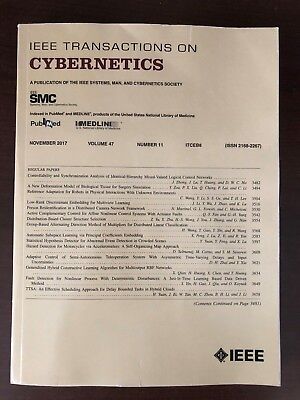二阶多智能体系统的隐私保护共识控制:位置和速度同步摄动方法。
IF 10.5
1区 计算机科学
Q1 AUTOMATION & CONTROL SYSTEMS
引用次数: 0
摘要
本文研究二阶积分器多智能体系统(MASs)共识控制中的隐私保护问题。具体来说,我们考虑的设置是,每个合法代理的初始位置和速度都是私有的,内部或外部的对手希望根据其获得的信息识别它们。针对这种情况,我们提出了一种基于位置和速度同步摄动技术的隐私保护算法。具体来说,我们的算法包括一个协同置乱阶段和一个收敛阶段。在置乱阶段,要求每个agent产生两组基于边缘的扰动信号,在传输前分别对局部位置和速度信号施加扰动,以保护隐私;在收敛阶段,每个agent按照正常规则更新自己的状态,以达到准确的共识。此外,我们建立了一个系统理论框架,通过检查私有值的任意变化对对手的不可区分性来分析隐私性能,并进一步表明,内部对手不能推断合法代理的隐私,只要它至少有一个合法的内邻居或外邻居,并且一旦代理以双向方式独家连接到内部对手,隐私就会泄露。对于外部窃听者来说,如果置乱阶段的增益参数是无法获得的,那么他们永远无法推断出任何代理的隐私。最后,通过两个仿真实例验证了所提方法的有效性。本文章由计算机程序翻译,如有差异,请以英文原文为准。
Privacy-Preserved Consensus Control for Second-Order Multiagent Systems: a Position and Velocity Simultaneous Perturbation Approach
In this article, we consider the problem of privacy preservation in consensus control for second-order integrator multiagent systems (MASs). Specifically, we consider the setting where the initial position and velocity of each legitimate agent are both private, an internal or external adversary wants to identify them based on the information it obtains. To deal with this scenario, we propose a privacy preservation algorithm based on a position and velocity simultaneous perturbation technique. To be specific, our algorithm consists of a collaborative scrambling phase and a convergence phase. In the scrambling phase, each agent is required to produce two sets of edge-based perturbation signals that are, respectively, imposed on the local position and velocity signals before transmission, with the purpose of preserving privacy; in the convergence phase, each agent updates its state per a normal rule, aiming to achieving accurate consensus. Also, we establish a system-theoretic framework to analyze privacy performance by examining the indistinguishability of private values’ arbitrary variations to adversaries, and further show that, an internal adversary cannot infer the privacy of a legitimate agent provided it has at least one legitimate in-neighbor or out-neighbor, and the privacy is leaked out once that agent exclusively connects to the internal adversary in bidirectional way. As for external eavesdroppers, they can never infer any agent’s privacy if the gain parameters in the scrambling phase are not accessible to them. Finally, two simulation examples illustrate the validity of the proposed approach.
求助全文
通过发布文献求助,成功后即可免费获取论文全文。
去求助
来源期刊

IEEE Transactions on Cybernetics
COMPUTER SCIENCE, ARTIFICIAL INTELLIGENCE-COMPUTER SCIENCE, CYBERNETICS
CiteScore
25.40
自引率
11.00%
发文量
1869
期刊介绍:
The scope of the IEEE Transactions on Cybernetics includes computational approaches to the field of cybernetics. Specifically, the transactions welcomes papers on communication and control across machines or machine, human, and organizations. The scope includes such areas as computational intelligence, computer vision, neural networks, genetic algorithms, machine learning, fuzzy systems, cognitive systems, decision making, and robotics, to the extent that they contribute to the theme of cybernetics or demonstrate an application of cybernetics principles.
 求助内容:
求助内容: 应助结果提醒方式:
应助结果提醒方式:


